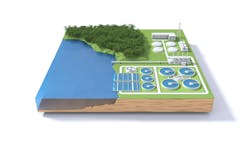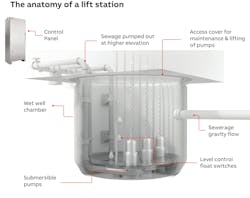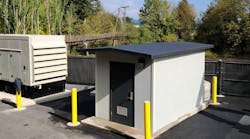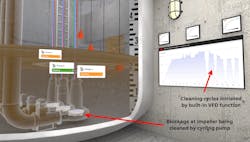4 problems that take pumps offline and how to handle them
Wastewater lift stations serve the crucial function of efficiently pumping wastewater to higher elevations for eventual treatment at municipal facilities. They provide pollution abetment and flood control for residential, commercial, and industrial rate payers and are expected to operate autonomously, even during extreme weather conditions. Lift stations are mechanically and electrically designed to withstand typical adverse operating conditions with backup systems either on-site or nearby for rapid deployment and recovery. However, there are four common enemies to uninterrupted lift station operations that can be overcome with modern variable frequency drives (VFD) in a new design or a retrofit.
1. Poor power quality
Lift stations need balanced, uninterrupted and clean power always to ensure the well level is maintained and there are no equipment trips or fails that have the potential to cause an overflow of untreated waste.
In normal and emergency operations modes, you may not be aware that your facility is vulnerable to hidden poor power conditions such as input voltage sags, phase to phase imbalance, and harmonic waveform distortions, that can impede proper pumping operations. In addition, lift stations are often in more remote locations at the far end of the power supply line and can suffer more disturbances and undervoltage conditions than other more centralized facilities.
When utility power is unavailable, you must rely on backup generators to provide power. If you are using traditional Variable Frequency Drives (VFDs), the generator (whether on-site or roll-up) may not operate as expected or may trip offline unless it is sized correctly for peak flow operation considering the oversizing needed for VFD loads.
VFDs that employ active front end (AFE) technology provide a solution to many of these problems. By design AFE technology endures and “rides through” many of the disturbances that a traditional “6 pulse” VFD is extremely susceptible to. In addition, “6 pulse” VFDs can produce high frequency voltage and current harmonics that can cause trips and malfunctions in generators and introduce problems to surrounding electrical systems and electronic devices. AFE ultralow harmonic variants are designed to comply with stringent IEEE519 harmonic standards, with no costly additional mitigation components needed.
The use of AFE drives that do not pass energy back to the supply also mean lifts stations do not need costly oversized generators or transformers that traditional VFD solutions require, saving both design costs in the case of new facilities, or roll-up generator hire and hookup costs in older stations.
2. Blocked pumps
In recent years, consumer use of various “flushable wipes” has increased dramatically, but few people outside the wastewater industry give a second thought to what happens when they are flushed and pass into the treatment network. Added to other rags and debris that can be present at the same time (such as sanitary products, cotton buds and even diapers) along with the fats, oils and greases that are often disposed into the waste system, it is not a surprise when they all combine to cause damaging pump blockages.
Pumps that are blocked or clogged with rags and debris can cause huge problems for wastewater collection systems. Lift stations are particularly susceptible as they are often the first pump that effluent reaches in a wastewater network prior to any screening, and the pumps are normally submerged in a wet well that can only be accessed from above with cranes or hoists.
Every time a pump is blocked, costs are incurred due to the time and the risks it takes to safely and properly lift out and clean the pumps. These high maintenance costs can, in most cases, be reduced with pump cleaning and deragging functions that are built into modern VFDs. They can perform several user defined speed and acceleration cleaning cycles, either backwards and forwards or just forwards, which can dislodge the blockage and clear the impeller without intervention. They also can signal their condition to operators locally or remotely via remote terminal units (RTUs).
3. Extreme environments
The construction materials and process equipment used with wastewater lift stations must be able to withstand a wide range of extreme conditions. Corrosive liquids and gases in which VFDs and other pieces of equipment are installed can cause damage, degradation, and premature failure leading to increased chances of overflows and spills. These can create the potential for expensive repairs and significantly decreases equipment service life.
Sensitive electronics components in VFDs need to be protected from the harsh environment to ensure longevity of service if a VFD is installed where gases and chemicals prevail. It is also important to choose VFDs that meet the most current [ISO] standards for corrosive environments, and the manufacturer needs to perform stringent accelerated life testing to ensure reliability under exposure.
Conformal coating of electrical board and components — standard on some VFDs — can help prevent problems caused by the ingress of chemicals, gases, moisture and other contaminants in the VFD installation environment. This leads to extended life by reducing rust and oxidization, chemical corrosion, dendrite growths and other consequences of contamination that can cause the sensitive components to fail.
It is good practice to separate or isolate the electrical control enclosure and all things contained in that enclosure from the sewage gases that cause corrosion and premature failures. Some VFDs offer a variety of enclosure options where the equipment must be installed in these locations, from NEMA/UL Type 1 and 12 to 4X (IP66), while meeting stringent chemical exposure standards. The extreme class 4X drive can be mounted outside of an enclosure with the advantage of lower cost installation closer to the pump while enduring the extreme environmental and gas and chemical conditions.
4. Water hammer
Water hammer’s destructive shock waves cause major problems in sewer systems, potentially causing leaks and ruptures or collapses, leading to spills and overflows that cause environmental issues and permit non-compliance in addition to the negative publicity that spills often generate.
The effect can be extremely hard on aging infrastructure that has been in place for many decades and can cause leaks at multiple points in collection systems, from damaged pump seals, valve seats, cracked pipes and breaks, which are very expensive to repair and maintain.
The first step to eliminating water hammer is understanding how a motor responds to different starting techniques. Commonly used methods, such as direct across the line, wye-delta starters, and soft starters all have the potential to produce pressure transients that can lead to water hammer.
VFDs can be employed to accurately control pump speed to ramp up water pressure or flow in a manner that avoids these damaging peaks. Using advanced algorithms such as soft pipe fill and ramped pump speed changes, as well as implementing closed-loop process control for well level and flow control, advanced VFDs will help control and eliminate water hammer and extend service life of assets, especially when upgrades and improvements have not been implemented or planned in the short term.
Installing VFDs into existing networks offers a low impact solution to solving water hammer, often paying back the offset in maintenance and repairs that are no longer required, within the space of months.
About the Author
Jim Turner
Jim graduated with a degree in Electrical Engineering from Auburn University and has worked in the Drives industry for 28 years. He is the industry manager for the water and wastewater segments at ABB’s New Berlin, Wisconsin located manufacturing facility. For more information, visit new.abb.com/drives




